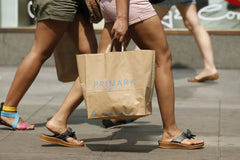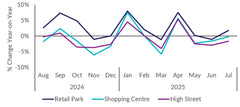
Warby Parker Shifts Focus: Ending Home Try-On Program to Enhance In-Store Experience
Table of Contents
- Key Highlights:
- Introduction
- The Rise and Fall of Home Try-On
- Financial Performance: A Positive Outlook
- Enhancing In-Store Experiences
- Future Projections and Strategic Goals
- Leadership Changes and Organizational Dynamics
- The Impact of Digital Tools
- Competitive Landscape and Industry Trends
- Conclusion
Key Highlights:
- Warby Parker will discontinue its home try-on program by the end of 2025, shifting focus towards in-store and online shopping experiences.
- The eyewear retailer reported a 14% increase in Q2 revenues, reaching $214.5 million, alongside a significant reduction in net losses.
- The company's active customer base grew by 9%, and they anticipate total annual revenues between $880 million and $888 million.
Introduction
Warby Parker, a trailblazer in the eyewear industry known for its direct-to-consumer (DTC) approach, has announced a strategic pivot that marks a significant change in its customer engagement strategy. The company plans to sunset its popular home try-on program by the end of 2025, a decision stemming from the evolving dynamics of consumer behavior and the company's expansion into physical retail. As the retailer reports robust financial growth in its second-quarter earnings, this shift signals a new era focused on enhancing in-store experiences and leveraging digital tools for customer engagement.
The Rise and Fall of Home Try-On
Warby Parker's home try-on initiative was a groundbreaking offering when it was launched. It allowed customers to select five pairs of glasses to try on at home for five days, revolutionizing how consumers approached eyewear shopping. Co-founder Neil Blumenthal emphasized that the program was particularly effective during the pandemic when many consumers were hesitant to visit physical stores. However, as Warby Parker has established a significant physical presence—with 300 stores and plans for more—executives now see a diminishing need for this at-home option.
The decision to discontinue the home try-on program is reflective of changing consumer habits. The majority of recent users of the program reside within a 30-minute radius of a Warby Parker store, indicating that customers are increasingly opting for in-person shopping experiences. This insight has prompted the company to refocus its efforts on enhancing the in-store shopping experience, which has been bolstered by a recent expansion in service offerings.
Financial Performance: A Positive Outlook
Warby Parker's financial health remains robust, as evidenced by its latest earnings report. The company reported a net revenue increase of 14% year-over-year, reaching $214.5 million. Notably, the net loss for the quarter narrowed significantly to $1.8 million, a marked improvement attributed to several factors, including a strategic reduction in operational costs associated with the home try-on program.
The financial report revealed a one-time cost of $3.8 million linked to the program's closure, encompassing $2.5 million in inventory write-downs and $1.3 million in restructuring expenses. Despite these costs, Warby Parker's active customer base grew by 9%, reaching 2.6 million, while average revenue per customer rose by 4.6% to $316. This growth trajectory is a promising indicator of the brand’s resilience and adaptability in a competitive market.
Enhancing In-Store Experiences
In conjunction with its increasing focus on physical retail, Warby Parker is enhancing its in-store experiences. This includes the introduction of eye exams at many locations, which have seen a remarkable year-over-year growth of 44%, contributing to 6% of the company’s total revenue. By integrating eye care services into its retail model, Warby Parker not only diversifies its offerings but also fosters a deeper connection with customers who prioritize convenience and comprehensive service.
The company celebrated the opening of its 300th store recently and plans to launch an additional 45 locations this year. This expansion includes innovative partnerships, such as the introduction of Warby Parker shop-in-shops within Target stores, allowing for greater accessibility to products while reaching a broader customer base.
Future Projections and Strategic Goals
Looking ahead, Warby Parker has raised its full-year revenue outlook, now estimating net revenue between $880 million and $888 million—up from previous guidance of $869 million to $886 million. This optimistic forecast reflects the brand's commitment to strengthening its market position through focused strategies that prioritize customer engagement and experience.
The decision to phase out the home try-on program, coupled with the expansion of brick-and-mortar locations and enhanced services, positions Warby Parker to capitalize on its growing customer base while adapting to the evolving retail landscape. This strategic realignment showcases the company’s agility and foresight in an industry that is rapidly changing.
Leadership Changes and Organizational Dynamics
Accompanying these strategic shifts is a notable change in Warby Parker's leadership. CFO Steve Miller will step down from his position effective October 1, after serving in the role for 14 years. Co-founder and co-CEO Dave Gilboa will temporarily take on Miller's responsibilities while the search for a successor commences. This transition signals a potential shift in corporate strategy and financial management as the company seeks to navigate its next phase of growth.
The Impact of Digital Tools
As Warby Parker emphasizes its digital-first approach, the company is not abandoning online engagement altogether. Instead, it aims to enhance its online tools, such as the virtual try-on feature, which allows customers to visualize how eyewear would look on their faces without needing to visit a store. This blend of physical and digital shopping experiences is designed to meet the needs of a diverse customer base, offering both convenience and personalized service.
Competitive Landscape and Industry Trends
Warby Parker's strategic shift comes amid a broader trend in the retail eyewear industry, where the balance between online and offline shopping continues to evolve. Competitors are increasingly investing in physical retail spaces while maintaining a robust online presence. This trend suggests that brands must be versatile, offering seamless transitions between online browsing and in-store experiences to cater to consumer preferences.
The rise of omnichannel retailing has transformed the way brands approach customer engagement. Companies that can effectively blend these experiences—offering convenience, personalized service, and innovative product offerings—are likely to thrive in an increasingly competitive marketplace.
Conclusion
Warby Parker's decision to discontinue its home try-on program marks a significant turning point for the eyewear retailer as it refocuses its efforts on enhancing in-store experiences and leveraging its growing network of physical locations. With strong financial performance and a commitment to adapting to consumer preferences, the company is poised for continued success in the evolving landscape of retail eyewear. As it navigates this new chapter, Warby Parker's strategic decisions will serve as a case study for other brands seeking to balance digital and physical retail strategies effectively.
FAQ
Why is Warby Parker ending its home try-on program?
Warby Parker is discontinuing its home try-on program as a strategic shift to focus on in-store customer experiences, as most recent users live near physical locations.
How has Warby Parker performed financially in recent quarters?
The company reported a 14% increase in revenue in Q2, reaching $214.5 million, with a narrowed net loss of $1.8 million.
What are Warby Parker's plans for expanding its physical locations?
Warby Parker plans to open an additional 45 stores this year, including shop-in-shops within Target, to enhance accessibility and customer engagement.
What changes are occurring in Warby Parker's leadership?
CFO Steve Miller is stepping down, with co-founder Dave Gilboa taking over his responsibilities temporarily while a successor is sought.
How is Warby Parker adapting its online strategy?
The retailer plans to enhance its digital tools, including the virtual try-on feature, to complement its physical retail offerings and meet consumer needs.
Power your ecommerce with our weekly insights and updates!
Hold deg oppdatert på hva som skjer i handelsverdenen
E-postadresse
Håndplukket for deg

07 August 2025 / Blog
UK Retail Footfall Decline: The Struggle for High Streets Amid Empty Shops and Consumer Caution
Les mer
07 August 2025 / Blog
The State of Customer Service: Generational Perspectives and Emerging Trends
Les mer
07 August 2025 / Blog


